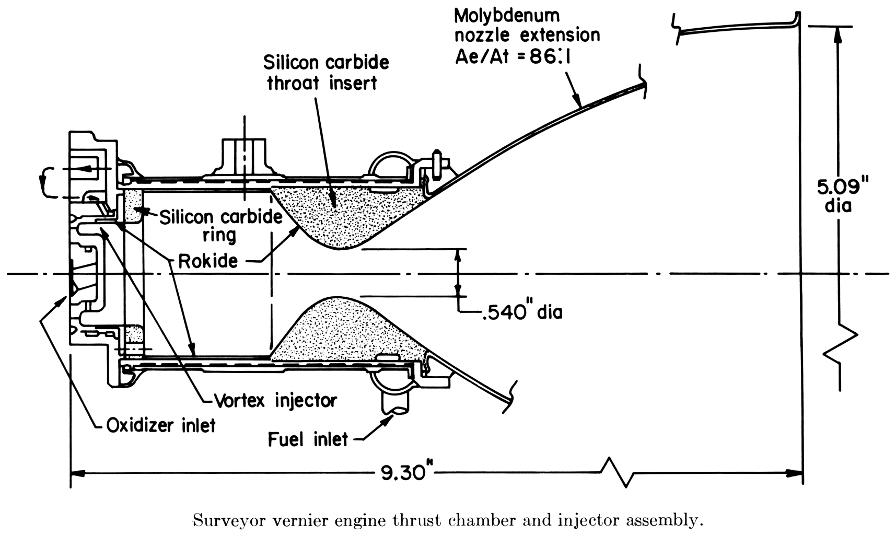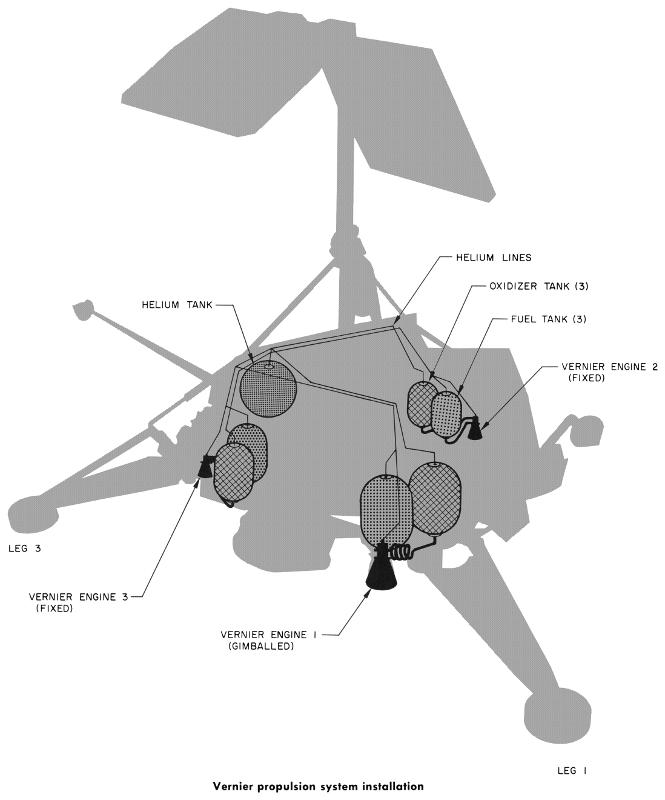TD-339 (Surveyor Vernier) Rocket Engine
The Surveyor lunar probe was a three-legged spacecraft. Located near the hinge points of each landing leg was a Thiokol Rocket Motors Division (RMD) TD-339 vernier engine. Each engine's thrust could be throttled over a range of 30 to 104 lb. Two of the engines were fixed, while the third could gimbal.
Here is a Thiokol promotional photo featuring a TD-339 engine:
Click image for a 943x1116 pixel version of this image in a new window.
Thiokol Chemical Corp. Reaction Motors Div. photo #8705-187. From an eBay auction listing.
Cleanup by heroicrelics.
A photo of one of the non-gimballed TD-339 mounted near a landing leg hinge point:
Click image for a 3431x2052 pixel version of this image in a new window.
From page 73 of the Surveyor III Mission Report Part I. Mission
Description and Performance (Technical Report 32-1177). Located in the
Kramer collection, Dept. of
Archives/Special Collections, M. Louis Salmon Library, University of
Alabama in Huntsville. Also available in electronic format from the Apollo 12 Lunar Surface
Journal.
Scan and cleanup by heroicrelics.
The TD-339 thrust chamber and injector assembly was 9.3 inches long and the nozzle's diameter at the exit plane was 5.09 inches. It used a regeneratively-cooled combustion chamber with a silicon carbide throat insert. The thrust chamber nozzle extension, made of high-temperature molybdenum, was radiation-cooled.
The engine employed a somewhat unusual injector: Rather than the more-common impinging jet or coaxial element injector, the TD-339 used a vortex injector. The vortex injector provided a swirling or cyclone combustion, similar to systems used in industrial furnaces. The vortex system operated at a high efficiency, required a minimal combustion chamber volume, and imposed reduced thermal loads on the combustion chamber walls. The rotational flow pattern, created from the tangential injection of propellant, increased the stay or mixing time of propellants in the combustion chamber, thus promoting high combustion efficiencies.
Click image for a 3431x2052 pixel version of this image in a new window.
From page 370 of Liquid Propellant Rocket Combustion Instability
(SP-194). Located in the NASA SP Collection, Dept. of Archives/Special
Collections, M. Louis Salmon Library, University of Alabama in Huntsville.
Also available in electronic format from the NASA Technical Reports
Server
Scan and cleanup by heroicrelics.
Each engine had a dedicate pair of propellant tanks, using mixed oxides of nitrogen (90% nitrogen tetroxide with 10% nitric oxide) as an oxidizer and monomethyl hydrazine monohydrate (MMH with water) as fuel; this combination ignites hypergolically when mixed in the thrust chamber. Each propellant tank contained a teflon expulsion bladder to ensure propellant control under zero-g conditions and all six tanks shares a high-pressure helium system.
A diagram illustrating the vernier propulsion system's main elements:
Click image for a 4392x5281 pixel version of this image in a new window.
From page 71 of the Surveyor III Mission Report Part I. Mission
Description and Performance (Technical Report 32-1177). Located in the
Kramer collection, Dept. of
Archives/Special Collections, M. Louis Salmon Library, University of
Alabama in Huntsville. Also available in electronic format from the Apollo 12 Lunar Surface
Journal.
Scan and cleanup by heroicrelics.
The vernier propulsion system in place with other spacecraft systems. The large, unmarked circle at center is the Surveyor's retromotor, which is jettisoned about 25,000 feet above the lunar surface (see the "terminal descent nominal events" diagram below).
Click image for a 5627x4989 pixel version of this image in a new window.
Adapted from page 173 of the Surveyor III Mission Report Part I. Mission
Description and Performance (Technical Report 32-1177). Located in the
Kramer collection, Dept. of
Archives/Special Collections, M. Louis Salmon Library, University of
Alabama in Huntsville. Also available in electronic format from the Apollo 12 Lunar Surface
Journal.
Scan, adaptation, and cleanup by heroicrelics.
After being launched toward the moon on an Atlas-Centaur, the vernier propulsion system was used to perform a midcourse correction maneuver (the failure of one of the verniers during its midcourse correction burn caused Surveyor II to tumble, leading to the loss of the mission).
The vernier engines were also used during terminal lunar descent (the information provided here is specifically from the Surveyor III mission). Surveyor used a solid retrorocket to slow its velocity by nearly 95% in preparation for soft landing; 38 minutes prior to retro ignition, the verniers provided the yaw-pitch-roll maneuver required to properly align the retrorocket nozzle. For the terminal descent maneuver (initiated approximately 51 miles from the lunar surface at a speed of nearly 5,900 mph), all three verniers began firing, followed about 1.1 seconds later by the solid retromotor. The retro completed its burn and was jettisoned at a distance of about 6.8 miles from the moon with the spacecraft at a speed of 335 mph. The verniers continued firing, controlled and throttled by the radar altimeter and doppler velocity sensor (RADVS), to slow Surveyor III to 4 mph. It was intended to cut off the verniers at an altitude of 14 feet, to reduce surface disturbance by the engines and to allow Surveyor III to fall unpowered, but one of the RADVS beams lost lock. The loss of altitude information prevented the vernier cut-off signal from being generated, and with the verniers producing a thrust equal to about 90% of the spacecraft lunar weight, Surveyor III bounced twice before a ground command cut the engines, allowing it to finally settle on the lunar surface.
On Surveyor III, particles of lunar dust kicked up by the verniers adhered to television camera mirror, partially obscuring the camera's images. On several later missions, the verniers were reignited as part of experiments to test surface permeability, surface cohesion, response to gas erosion, and adhesion of lunar dust to the spacecraft itself. In one test, clumps of material kicked up by the verniers struck the Surveyor, splattered, and formed an adhesive coating. (I was unable to determine whether these experiments were planned prior to the Surveyor III incident or whether they were inspired by it.)
Click image for a 3431x2052 pixel version of this image in a new window.
From page 39 of the Surveyor III Mission Report Part I. Mission
Description and Performance (Technical Report 32-1177). Located in the
Kramer collection, Dept. of
Archives/Special Collections, M. Louis Salmon Library, University of
Alabama in Huntsville. Also available in electronic format from the Apollo 12 Lunar Surface
Journal.
Scan and cleanup by heroicrelics.
The National Air & Space Museum formerly displayed a TD-339, in the same engine display as their early Ascent Propulsion System engine (in the background, just to the right of the APS engine); that TD-339 appears to be collection ID #A19700233000. The Smithsonian also has a second TD-339 in its collection, collection ID #A19790174000.






